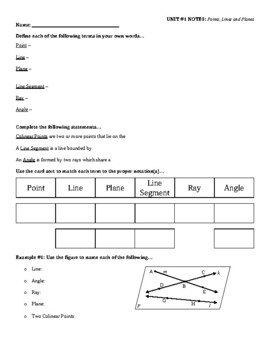Unit #1 Notes: Points, Lines, and Planes
161 Downloads
Beyond the Norm Mathematics
3 Followers
Grade Levels
7th - 11th
Subjects
Resource Type
Standards
CCSSHSG-CO.A.1
CCSSHSG-CO.C.9
CCSSHSG-GPE.B.5
CCSSMP1
CCSSMP2
Formats Included
- PDF
Pages
1 page
Beyond the Norm Mathematics
3 Followers
Description
This is a sample of the first page of notes from my Unit #1 Guided Notes Set. My Geometry Curriculum comes with a full lesson plan for each day. There are 8 units total. Each unit includes...
- 1 unit outline
- 5 bell ringers
- 5 guided notes pages
- 5 discovery or extension activities
- 1 review task or activity
- 2 quizzes
- 1 unit exam
- 1 calculating grades paper
I will also upload a Unit Assessments Set for those who may want the exams or quizzes only.
Total Pages
1 page
Answer Key
Not Included
Teaching Duration
1 Semester
Last updated Aug 2nd, 2022
Report this resource to TPT
Reported resources will be reviewed by our team. Report this resource to let us know if this resource violates TPT’s content guidelines.
Standards
to see state-specific standards (only available in the US).
CCSSHSG-CO.A.1
Know precise definitions of angle, circle, perpendicular line, parallel line, and line segment, based on the undefined notions of point, line, distance along a line, and distance around a circular arc.
CCSSHSG-CO.C.9
Prove theorems about lines and angles.
CCSSHSG-GPE.B.5
Prove the slope criteria for parallel and perpendicular lines and use them to solve geometric problems (e.g., find the equation of a line parallel or perpendicular to a given line that passes through a given point).
CCSSMP1
Make sense of problems and persevere in solving them. Mathematically proficient students start by explaining to themselves the meaning of a problem and looking for entry points to its solution. They analyze givens, constraints, relationships, and goals. They make conjectures about the form and meaning of the solution and plan a solution pathway rather than simply jumping into a solution attempt. They consider analogous problems, and try special cases and simpler forms of the original problem in order to gain insight into its solution. They monitor and evaluate their progress and change course if necessary. Older students might, depending on the context of the problem, transform algebraic expressions or change the viewing window on their graphing calculator to get the information they need. Mathematically proficient students can explain correspondences between equations, verbal descriptions, tables, and graphs or draw diagrams of important features and relationships, graph data, and search for regularity or trends. Younger students might rely on using concrete objects or pictures to help conceptualize and solve a problem. Mathematically proficient students check their answers to problems using a different method, and they continually ask themselves, "Does this make sense?" They can understand the approaches of others to solving complex problems and identify correspondences between different approaches.
CCSSMP2
Reason abstractly and quantitatively. Mathematically proficient students make sense of quantities and their relationships in problem situations. They bring two complementary abilities to bear on problems involving quantitative relationships: the ability to decontextualize-to abstract a given situation and represent it symbolically and manipulate the representing symbols as if they have a life of their own, without necessarily attending to their referents-and the ability to contextualize, to pause as needed during the manipulation process in order to probe into the referents for the symbols involved. Quantitative reasoning entails habits of creating a coherent representation of the problem at hand; considering the units involved; attending to the meaning of quantities, not just how to compute them; and knowing and flexibly using different properties of operations and objects.


